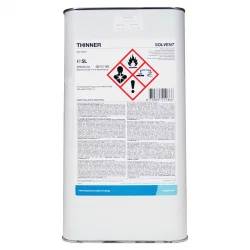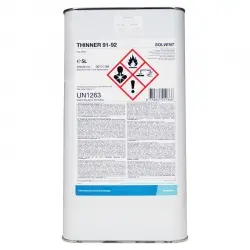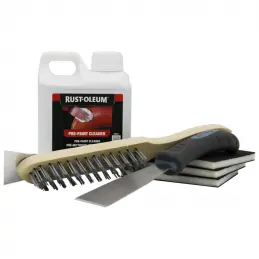- There are no more items in your cart
- Shipping Calculated at checkout
- Sub-Total (inc. VAT) £0.00
PPG SigmaTherm 230 is a two-component, high-build, heat-resistant epoxy phenol novolac coating that provides a corrosion resistant barrier on carbon steel and stainless steel under thermal insulation. Suitable as heat resistant system under insulation up to 230°C (450°F) as well as for use in cryogenic conditions.
- Meets CS-1, 3 and 4 for carbon steels under thermal insulation according to NACE SP0198-10
- Meets SS-1, 2 and 3 for stainless steels under thermal insulation according to NACE SP0198-10
- No post-curing is required to obtain mechanical strength
PPG SigmaTherm 230 is a two-component, high-build, heat-resistant epoxy phenol novolac coating that provides a corrosion resistant barrier on carbon steel and stainless steel under thermal insulation. Suitable as heat resistant system under insulation up to 230°C (450°F) as well as for use in cryogenic conditions.
Features & Benefits
- Excellent protection and resistance against corrosion and severe chemicals
- Excellent resistance to thermal shock during rapid wet & dry cycling
- Meets CS-1, 3 and 4 for carbon steels under thermal insulation according to NACE SP0198-10
- Meets SS-1, 2 and 3 for stainless steels under thermal insulation according to NACE SP0198-10
- No post-curing is required to obtain mechanical strength
- Can be applied on hot substrate up to 150°C (302°F); please contact our technical team for details
Product Data
Two-component, high-build, heat-resistant epoxy phenol novolac coating.
Epoxy coatings will chalk and fade upon exposure to sunlight, elevated temperatures, or chemical exposure. Discolouration and normal chalking does not impact performance. Light colours will darken over time. Some batch-to-batch variation in colour is to be expected. Colour matches are approximate.
| Data for mixed product at 20°C (68°F) | |
|---|---|
| Number of components | Two |
| Mass density | 1.7 kg/l (14.2 lb/US gal) |
| Volume solids | 68 ± 2% |
| VOC (Supplied) | Directive 1999/13/EC, SED: max. 195.0 g/kg |
| max. 329.0 g/l (approx. 2.7 lb/US gal) | |
| EPA Method 24: 310.0 g/ltr (2.6 lb/USgal) | |
| Recommended dry film thickness | 100 - 150 µm (4.0 - 6.0 mils) |
| Theoretical spreading rate | 4.5 m²/l for 150 µm (182 ft²/US gal for 6.0 mils) |
| Dry to touch | 3 hours |
| Overcoating Interval | Minimum: 8 hours |
| Maximum: 14 days | |
| Full cure after | 3 days |
| Shelf life | Base: at least 12 months when stored cool and dry |
| Hardener: at least 12 months when stored cool and dry | |
Notes:
- Refer below for more details on spreading rate and film thickness, overcoating intervals and curing times
- To avoid crack in elevated temperature, it is recommended that the total average dry film thickness not exceed 350 µm (14 mils) and locally 400 µm (16 mils)
Surface Preparation
Recommended Substrate Conditions and Temperatures
Substrate conditions
- Steel - blast cleaned to ISO-Sa2½, blasting profile 40 – 70 µm (1.6 – 2.8 mils)
- The substrate must be perfectly dry before and during application of SigmaTherm 230
- Stainless steel; degrease with solvent and sweep blast, SSPC SP-16 with blasting profile 40 – 100 µm (1.5 – 4.0 mils)
Substrate Temperature & Application Conditions
- Substrate temperature during application and curing should be above 5°C (41°F)
- Substrate temperature during application and curing should be at least 3°C (5°F) above dew point
Application
Instructions for Use
Mixing ratio by volume: base to hardener 87:13
- The temperature of the mixed base and hardener should preferably be above 15°C (59°F), otherwise extra thinner may be required to obtain application viscosity
- Adding too much thinner results in reduced sag resistance
- Thinner should be added after mixing the components
Induction Time
Allow induction time before use
| Mixed Product Induction Time | |
|---|---|
| Mixed Product Temperature | Induction Time |
| 5°C (41°F) | 20 minutes |
| 10°C (50°F) | 15 minutes |
| 15°C (59°F) | 10 minutes |
Air Spray
Recommended thinner
- PPG Thinner 91-92 for ambient temperature; PPG Thinner 21-25 for application to hot surfaces
Volume of thinner
- 5 - 10%, depending on required thickness and application conditions
Nozzle orifice
- 2.0 mm (approx. 0.079 in)
Nozzle pressure
- 0.3 MPa (approx. 3 Bar; 44 p.s.i.)
Airless Spray
Recommended thinner
- PPG Thinner 91-92 for ambient temperature; PPG Thinner 21-25 for application to hot surfaces
Volume of thinner
- 5 - 10%, depending on required thickness and application conditions
Nozzle orifice
- Approx. 0.46 – 0.53 mm (0.018 – 0.021 in)
Nozzle pressure
- 15.0 MPa (approx. 150 bar; 2176 p.s.i.)
Brush/roller
Recommended thinner
- PPG Thinner 91-92
Volume of thinner
- 0 – 5%
Cleaning Solvent
Spreading Rate and Film Thickness
Overcoating interval for DFT up to 150 µm (6.0 mils)
| Overcoating with... | Interval | 5°C (41°F) | 10°C (50°F) | 15°C (59°F) | 20°C (68°F) | 30°C (86°F) |
|---|---|---|---|---|---|---|
| Itself | Minimum | 24 hours | 20 hours | 14 hours | 8 hours | 6 hours |
| Maximum | 28 days | 25 days | 21 days | 14 days | 7 days |
Notes:
- Surface should be dry and free from any contamination
Curing time for DFT up to 150 μm (6.0 mils)
| Substrate temperature | Dry to Touch | Dry to Handle | Full Cure |
|---|---|---|---|
| 5°C (41°F) | 28 hours | 60 hours | 7 days |
| 10°C (50°F) | 12 hours | 30 hours | 5 days |
| 15°C (59°F) | 6 hours | 15 hours | 4 days |
| 20°C (68°F) | 3 hours | 5 hours | 3 days |
| 30°C (86°F) | 2 hours | 4 hours | 48 hours |
Notes:
- Adequate ventilation must be maintained during application and curing (please refer to information sheets information sheet 1433 and Directives for Ventilation Practice information sheet 1434)
Pot Life (at application viscosity)
| Mixed product temperature | Pot life |
|---|---|
| 5°C (41°F) | 8 hours |
| 10°C (50°F) | 6 hours |
| 15°C (59°F) | 4 hours |
| 20°C (68°F) | 2 hours |
| 30°C (86°F) | 1 hour |
Safety Precautions
- For paint and recommended thinners, see information sheets information sheet 1430, information sheet 1431 and the relevant Material Safety Data Sheets in the attachments section above
- This is a solvent-borne paint and care should be taken to avoid inhalation of spray mist or vapour, as well as contact between the wet paint and exposed skin or eyes
References
- Conversion Tables (information sheet 1410)
- Explanation to product data sheets (information sheet 1411)
- Safety Indicators (information sheet 1430)
- Safety in Confined Space and Health Safety, Explosion Hazard - Toxic Hazard (information sheet 1431)
- Safe Working in Confined Spaces (information sheet 1433)
- Directives for Ventilation Practice (information sheet 1434)
- Cleaning of Steel and Removal of Rust (information sheet 1490)
- Specification for Mineral Abrasives (information sheet 1491)
- Relative humidity - Substrate Temperature - Air Temperature (information sheet 1650)
Data sheet
- Manufacturer
- PPG
- Water / Solvent Based
- Solvent
- Water / Solvent Based
- Solvent
- For Use On
- Carbon steel, stainless steel
- Sheen
- Gloss
- Colour
- Standard / Ready Mixed
- Single, Two or Three Pack
- Two-Pack
- Product Certifications
- NACE SP0198-10,
- Pack Size
- 20L
- Parts
- Two
- Base Type
- Epoxy phenol novolac
- Mixing Ratio
- 87:13
- Suitable Substrates
- Steel
- Key Features
- Meets CS-1, 3 and 4 for carbon steels under thermal insulation according to NACE SP0198-10, excellent protection and resistance against corrosion and severe chemicals
- Application
- Spray, Brush, Roller
- Touch Dry (at 20°C)
- 3 hours
- Dry to Handle (at 20°C)
- -
- Dry to Recoat (at 20°C)
- Minimum: 8 hours. Maximum: 14 days
- Fully Cured (at 20°C)
- 3 days
- Pot Life (at 20°C)
- 2 hours
- Coverage
- 4.5 m²/I for 150 µm (182 ft²/US gal for 6.0 mils)
- Recommended Thinner/Cleaner
- PPG Thinner 90-53, PPG Thinner 91-92
- Unit Contents
- -
- Compatible Primers
- -
- Compatible Topcoats
- Itself
- Max. Application Temperature
- 150°C (302°F)
- Min. Application Temperature
- 5°C (41°F)
- Density
- 1.7 kg/I (14.2 lb/US gal)
- Solids by Volume
- 68 ±2%
- Heat Resistance (up-to)
- 230°C
- VOC
- Directive 1999/13/EC, SED: max. 195.0 g/kg max. 329.0 g/I (approx. 2.7 lb/US gal) EPA Method 24: 310.0 g/ltr (2.6 lb/USgal)
- Shelf Life (Once Opened)
- Base/Hardener: at least 12 months when stored cool and dry
- UN Number
- UN1263, UN3469
- Base Type
- Solvent-Based
- Base Type
- Epoxy
- Suitable For Use On
- Stainless Steel
- Suitable For Use On
- Carbon Steel
- Finish
- Gloss
- Application Method
- Spray
- Application Method
- Brush
- Application Method
- Roller
- Product Usage Type
- Topcoat
- Product Range
- SigmaTherm
- Colour Family
- Grey
- Colour Family
- Pink
- Heat Resistance
- Up To 300°C
Questions
Question about the product
Be the first to ask a question about this product!
IMPORTANT SHIPPING & DELIVERY INFORMATION
PPG SigmaTherm 230 is only available with the shipping and delivery timescales listed below - please do not contact our Customer Support Team with enquiries about alternative or earlier shipping and delivery times.
Saturdays and Sundays, as well as Bank Holidays, are not classed as working days.
Orders placed after the cut-off for this product will not be processed for earliest dispatch until 9am the next working day.
All delivery costs below are excluding VAT

PPG Thinner 90-53
This thinner has been developed by PPG Protective and Marine Coatings for use with selected paint products.

PPG Thinner 91-92
This thinner has been developed by PPG Protective and Marine Coatings for use with selected paint products.

Surface Preparation Kits for Steel
These surface preparation kits for steel have been created to help provide customers with an easily accessible bundle of tools to aid in the preparation of steel surfaces in accordance with ISO 8501-1 (St2/3) and SSPC (SP 2/3). Please click here for important information about these kits. Kit Contents: SET 1 (Hand Tools)1 x Rust-Oleum...



